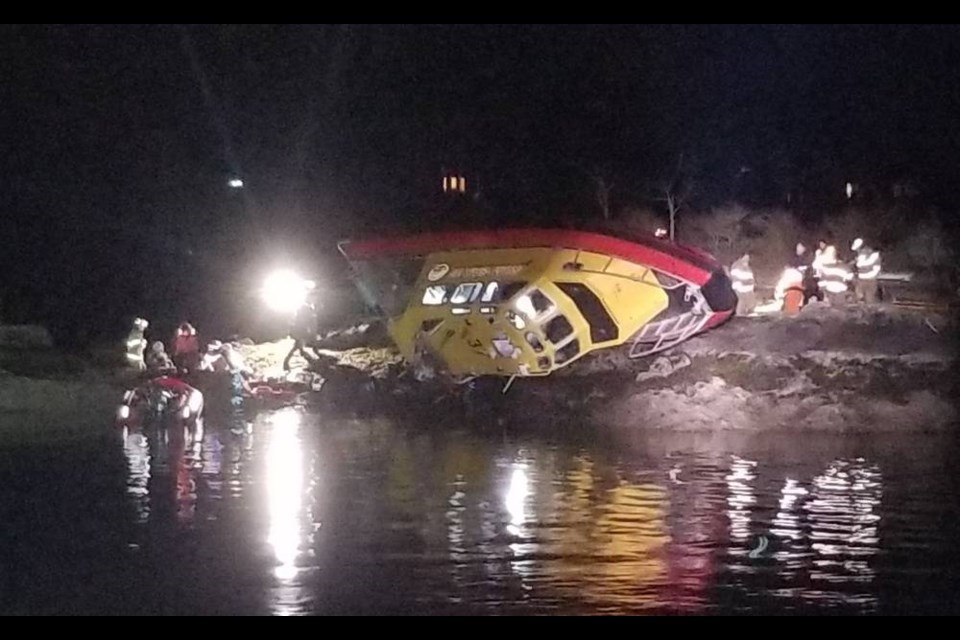Misinterpreting of navigational information and communication failures during a training exercise resulted in a marine search- and-rescue vessel speeding into the shore, rocketing up in the air, toppling and sliding, causing serious injuries to the volunteer crew, says a Transportation Safety Board report released Thursday.
Bill Riggs, chief executive officer of Royal Canadian Marine Search and Rescue, said the report is balanced.
“We fully agree with the conclusions that have come out,” he said, adding many of the TSB’s recommendations have been acted upon or are in progress.
On Feb. 7, 2019, the Spirit of Sooke, a rigid hull inflatable jet boat, departed Royal Canadian Marine Search and Rescue Station 37 in Sooke at about 8 p.m. with a coxswain in charge and three crew members, two of whom were new — a woman with nine hours of training and a man with six.
The trip to a fuelling depot in the Sooke basin, the body of water between Sooke and East Sooke, was an opportunity to train the new crew members in navigation and communications procedures, the report says.
The vessel set out on its return trip at 9:15 p.m. with a crew member at the helm and the coxswain navigating. The two new crew members had been assigned to maintain lookout in the middle and rear of the vessel.
The channel between the fuelling depot and the station in Sooke is narrow and marked by unlit buoys, and there is no navigational marker for Christie Point. It was dark, so the crew relied primarily on their radar, said Riggs.
As the vessel approached Christie Point, the coxswain monitored the radar display and instructed the one experienced crew member at the helm to make a course alteration. Seconds later, the coxswain “urgently” shouted the same course change when “almost immediately,” the Spirit of Sooke ran into shoreline rocks near Sooke.
“The vessel launched into the air and hit the ground stern first before sliding along the shore for approximately 25 metres and coming to rest on its starboard side, resulting in the crew members being thrown around the cabin in a violent manner and causing serious injuries,” the TSB report says. The crew suffered head, neck and leg injuries, in part because they did not wear four-point harnesses and helmets on the vessel.
The vessel was equipped with headsets that allow crew members to hear one another over the vessel’s engine, but they weren’t wearing them, which meant some of the communication was not clearly heard by all of the crew.
As the vessel approached Christie Point, the coxswain’s interpretation of the radar screen showed the boat was on a good course to clear the rocky point, but neither the chart plotter nor the radar were on a range setting that showed the coastal features leading to and including Christie Point.
The lookout was unable to see Christie Point because of darkness and absence of lit navigation devices. “Additionally, there was no experienced crew member available to actively monitor the vessel’s position and detect navigation error,” the report says.
Once the crew realized the vessel was about to hit the shore, there was not enough time to avoid it, given the vessel’s high speed.
Had the searchlights been left on, they would have illuminated Christie Point only about six seconds before impact.
The Spirit of Sooke ran into shoreline rocks on Christie Point at about 27 knots or 50 kilometres per hour. The crash occurred at 9:34 p.m.
The vessel, which was damaged under the water line and suffered electrical and engine damage, has since been repaired.
The report notes that around the time of the crash, crew members at Station 37 dropped to nine from 18, resulting in fewer certified coxswains being available to train volunteers.
The coxswain involved in the crash had been prohibited from driving a motor vehicle since 2014 and would have been prohibited from being a helmsman, although he was allowed to serve as coxswain. (RCMSAR says it was not aware of the prohibition.)
A little over a week prior to the crash, on Jan. 28, 2019, an inspection noted the station was in need of more coxswains and had seven to eight new members. There are now about 13 members.
The TSB report “provides an accurate picture of what occurred,” said Riggs, who came aboard last year after a nationwide search for a new head.
After the crash, operations at the station ceased and refresher training and skills-evaluation sessions for coxswains were held.
Training included a review of leadership and decision- making, presentations on navigation and on-the-water training with a focus on emergency procedures.
All coxswains at the station completed the refresher training and the station returned to operations.
Royal Canadian Marine Search and Rescue members are all volunteers who do “amazing” work, said Riggs — including searching for kayaker Timothy Ross, 38, who has been missing near Sooke since Sunday.
“Our training here is probably some of the top marine-based volunteer SAR training in Canada. They put in a lot of effort to maintain their training and their experience and they are quite willing to put themselves at risk at a moment’s notice to go and help somebody on the water, so I think it’s important to recognize the contribution they make.”
Three of those involved in the crash have since left the station, while one remains and took part in the search for Ross, he said.
The Transportation Safety Board is an independent agency that investigates transportation incidents to improve safety. It does not assign fault or determine civil or criminal liability.
RCMSAR is independent but operates under the guidance of the Canadian Coast Guard and the Department of National Defence.



